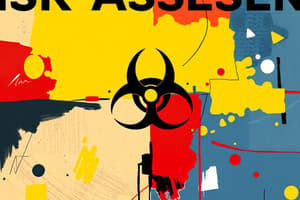Podcast
Questions and Answers
Which of the following is NOT considered a key element of Process Safety Management (PSM)?
Which of the following is NOT considered a key element of Process Safety Management (PSM)?
- Employee Participation
- Management of Change (MOC)
- Physical and Ergonomic Factors (correct)
- Incident Investigation
What is the main purpose of the Globally Harmonized System (GHS)?
What is the main purpose of the Globally Harmonized System (GHS)?
- To dictate emergency planning protocols
- To assess human performance in safety
- To manage workplace ergonomics
- To provide a standard for hazardous material labelling (correct)
Which of the following is a method used to classify human errors?
Which of the following is a method used to classify human errors?
- Fatigue Management
- Behavioral Safety Audits
- Cognitive Load
- Slip, Mistake, and Lapse (correct)
What is the primary focus of the Resource Conservation and Recovery Act (RCRA)?
What is the primary focus of the Resource Conservation and Recovery Act (RCRA)?
Which regulatory agency is associated with the Hazard Communication Standard (HCS)?
Which regulatory agency is associated with the Hazard Communication Standard (HCS)?
What role does 'Mechanical Integrity' play in Process Safety Management?
What role does 'Mechanical Integrity' play in Process Safety Management?
Which of the following is a training requirement under Hazardous Materials Management?
Which of the following is a training requirement under Hazardous Materials Management?
Which aspect of human performance involves the ability to perceive, understand, and react to surroundings?
Which aspect of human performance involves the ability to perceive, understand, and react to surroundings?
What does the term 'Management of Change (MOC)' refer to in a safety context?
What does the term 'Management of Change (MOC)' refer to in a safety context?
In what context is 'incident investigation' performed?
In what context is 'incident investigation' performed?
Flashcards
Process Hazard Analysis (PHA)
Process Hazard Analysis (PHA)
A systematic process of identifying and analyzing potential hazards, evaluating risks, and implementing controls to mitigate potential incidents.
Operating Procedures (SOPs)
Operating Procedures (SOPs)
A set of procedures designed to ensure safe and efficient operation of equipment, processes, and facilities.
Mechanical Integrity
Mechanical Integrity
Ensuring equipment is properly maintained to prevent failures and accidents.
Management of Change (MOC)
Management of Change (MOC)
Signup and view all the flashcards
Pre-Start Up Safety Reviews
Pre-Start Up Safety Reviews
Signup and view all the flashcards
Safety Audits
Safety Audits
Signup and view all the flashcards
Incident Investigation
Incident Investigation
Signup and view all the flashcards
Emergency Planning and Response
Emergency Planning and Response
Signup and view all the flashcards
Globally Harmonized System (GHS)
Globally Harmonized System (GHS)
Signup and view all the flashcards
Human Error
Human Error
Signup and view all the flashcards
Situational Awareness
Situational Awareness
Signup and view all the flashcards
Human Performance Tools
Human Performance Tools
Signup and view all the flashcards
HAZOP (Hazard and Operability Study)
HAZOP (Hazard and Operability Study)
Signup and view all the flashcards
Failure Modes and Effects Analysis (FMEA)
Failure Modes and Effects Analysis (FMEA)
Signup and view all the flashcards
Hazardous Materials Management
Hazardous Materials Management
Signup and view all the flashcards
Lapses
Lapses
Signup and view all the flashcards
Study Notes
PSM (Process Safety Management) Key Elements
- Employee Participation: Involve employees in decisions, feedback, and training.
- Process Hazard Analysis (PHA): Using methods like HAZOP and FMEA.
- Operating Procedures (SOPs): Standard Operating Procedures and emergency responses.
- Training: SOPs, emergency responses, equipment handling.
- Mechanical Integrity: Pressure vessels, pipelines, pumps, etc.
- Management of Change (MOC): Pre-start-up safety reviews.
- Safety Audits: Regular reviews of safety procedures.
- Incident Investigation: Investigating incidents to identify causes and prevent future ones.
- Emergency Planning and Response: Preparing for and responding to gas releases, fires, explosions, and chemical spills.
- Compliance with Standards and Regulations: Adhering to relevant safety regulations.
Hazardous Materials Management
- Identification and Classification of Hazardous Materials: Classifying substances based on flammability, corrosivity, reactivity, and toxicity, using SDS and GHS.
- Properties of Hazardous Materials: Understanding flammability, corrosivity, reactivity, and toxicity of materials.
- Classification and Labeling of Chemicals: Using globally standardized systems like GHS (Globally Harmonized System).
- Storage and Labelling: Proper storage and labeling of chemicals.
- Handling and Use: Training on handling and using hazardous materials including Personal Protective Equipment (PPE).
- Transportation and Shipping: Following regulations like DOT, IATA, and IMDG for transportation of hazardous materials.
- Disposal and Waste Management: Proper disposal methods according to regulations like RCRA.
Human Performance
- Human Error Classification: Identifying common types of errors (slips, mistakes, lapses).
- Cognitive Factors: Assessing attention, memory, and decision-making processes.
- Physical and Ergonomic Factors: Considering the physical demands and work environment on human performance.
- Work Environment and Organizational Culture: Assessing the impact of the culture on human performance.
- Training and Competency: Evaluating training programs and worker competency in safety procedures.
- Human Performance Tools: Utilizing tools like behavioral safety audits, performance feedback, checklists, and error reporting systems to identify and mitigate issues.
- Fatigue Management: Addressing fatigue as it affects human error and performance.
- Team Performance and Communications: Improving team performance and communication to ensure safety.
- Human Machine Interface (HMI): Understanding the interface between humans and machinery.
Liability Insurance Coverages
- Strict Liability: Holding parties accountable for damages even without proof of negligence.
- Product Liability: Coverage for issues arising from defects in products.
- General Liability: Coverage for general liability claims.
- Professional Liability/Errors and Omissions (E&O): Protection for professionals against errors and omissions in their work.
- Automobile Liability: Coverage for liability in events involving automobiles.
- Workmen's Compensation: Coverage for injuries to employees.
Studying That Suits You
Use AI to generate personalized quizzes and flashcards to suit your learning preferences.




